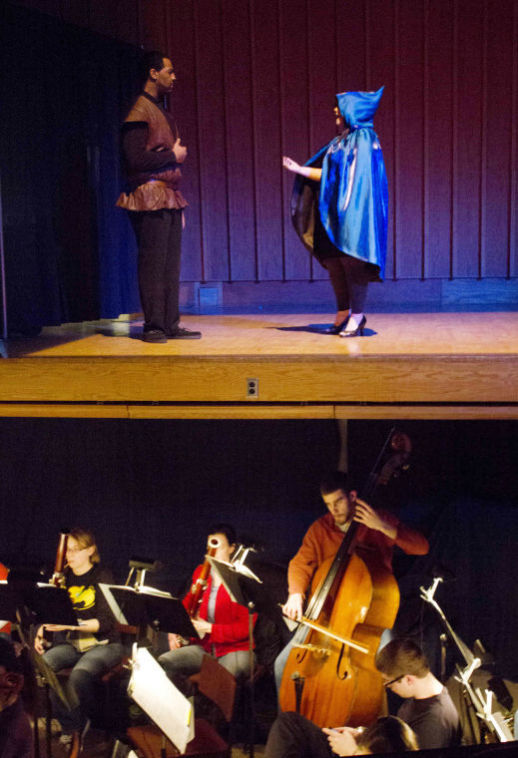‘The Magic Flute’ brings opera to NIU
March 20, 2013
An opera told with the help of a graphic novel on-screen might be a first in opera, let alone within NIU’s Music Building.
The NIU Opera Theatre will perform “The Magic Flute” at 8 p.m. Friday and 3 p.m. Sunday in the Boutell Memorial Concert Hall in the Music Building.
The opera was written by Wolfgang Amadeus Mozart, a classical-era composer. It tells the story of a prince, Tamino, whose life is saved after being attacked by a monster, and how Tamino embarks on a journey to save the princess named Pamina—the daughter of the Queen of the Night.
“The Magic Flute” is well-known for its vocal pieces, or arias, like the one sung by the Queen of the Night in Act II. Brittany Anderson, the junior vocal performance major who sings the part of the Queen of the Night, said it’s only perceived as a hard aria to sing because of how high one would have to go to sing it.
“It’s one of those pieces that, once you get it, you feel so accomplished,” Anderson said. “That was the first aria that I ever learned. To now be able to play it… it’s like now everything’s finally coming together.”
Mozart himself had a quick wit, making a single note in a composition really loud after a really quiet musical phrase. His music, especially in this humorous opera, reflects his playfulness, said senior music education major Andrew Szymanek.
“Mozart was kind of a goofy guy,” Szymanek said. “He liked to play tricks in his music sometimes. He liked to surprise people.”
“The Magic Flute” takes the style of singsprecht; the actual singing is in German, but the speaking and subtitles are in English. The opera is generally performed as a play, meaning it has a full set on stage and a screen above the stage projecting English subtitles to the audience.
This particular performance of “The Magic Flute” will take a different spin. While the setting of operas performed by the NIU Opera Theatre is minimalist by nature, Anthony Perrella Jr., stage director and NIU alumnus, will also add a slideshow of graphic novel—or comic book—panels that are projected in the middle of the stage area.
“You can see the world of the show on the screen, and then you can see the actors singing and you don’t need to see a set,” Perrella said.
The students of a time arts class, who are part of the School of Art, created the animation art for the production. Jessica Vadney, junior vocal performance major and one of the three attendants of the Queen of the Night, said to not let the foreign language aspect discourage anyone from attending the opera performance.
“A lot of people I know that are around our age…nobody will even give opera a chance,” Vadney said. “It’s a type of field that people think, ‘I’m not gonna understand it.’ They don’t realize that, when you go to the opera, it’s translated. You know everything that’s going on. People don’t realize that it’s actually a lot of fun—it’s fun to go to an opera. It’s not stuffy or boring—you understand what’s going on when you’re seeing it.”
Perrella used the graphic novel approach as a means to solve the problem of the language barriers and English subtitles.
“Maybe it doesn’t even make [the audience] think about opera,” Perrella said. “Maybe they just think about, ‘Wow, this was a really nice way to take in Mozart and understand what’s going on and be able to have the culture of listening to something in a foreign language.’”







